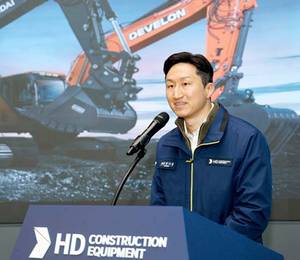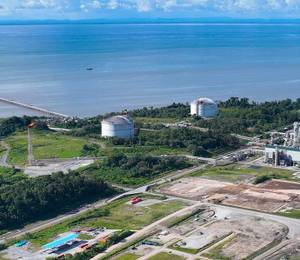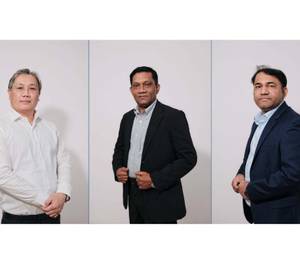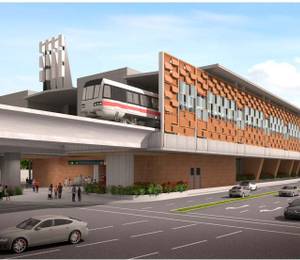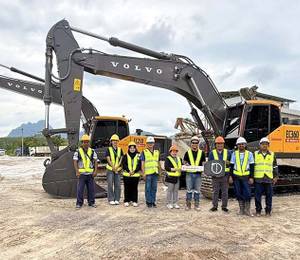The island of Lombok in Indonesia is increasingly known as a popular tourist attraction and thus offers a promising avenue for the country’s economic development. To provide balance in water availability between rainy and dry seasons, Indonesia’s Directorate of General Water commissioned PT Hutama Karya (Persero), a state-owned enterprise that executes infrastructure projects, to engineer a dam in the West Lombok Regency. This district stretches along most of the southwestern coast of the island.
The Indonesian government has deemed the Meninting Dam necessary for the development of the country’s infrastructure and economy, officially naming it a National Strategic Project for the Acceleration of Economic Growth in Indonesia.
“It will significantly support the agricultural sector of the locals, and also support economic growth by making a new destination for the tourism sector,” said Christy Vania, an engineer at PT Hutama Karya who is focused on building information modelling (BIM).
Improving safety
Work on the US$95.15 million Meninting Dam began in 2019 and is expected to last into 2023. When completed, the dam will be 79 m high with a water capacity of 12 mil cu m. It will irrigate more than 1,500 ha of agricultural property and ensure the availability of clean water to nearby Lombok residents and tourists. Additionally, the dam will provide an additional 0.8 MW of clean, hydroelectric power to the community.
However, to achieve this vision, PT Hutama Karya had to navigate tricky terrain. Parts of the site chosen for the dam were difficult to access, with thick trees and shrubbery and steep conditions. The undeveloped site presented an unknown degree of hazards for surveyors and construction workers. When the team attempted to survey the property using traditional methods, the data collection process was drawn-out and dangerous.
Considering these challenges, PT Hutama Karya decided to revolutionise its surveying and data collection by fully digitising the processes. The team used a drone with a flying distance of 7 to 8 km to capture images and data from the site’s hardest-to-reach areas. The drone’s findings were then processed using Bentley’s 3D reality modelling and real-time visualisation software to chart maps and monitor ongoing conditions at the site, identifying any new potential work hazards over time.
This methodology cut the time required for data collection and monitoring by half and contributed significantly to worker safety. In total, project engineers saved an estimated US$2.1 million in fees by avoiding potential work-related accidents.
“Because the terrain is very steep, there is a high potential for landslides. But we can say we had around 1,200,000 safe resource hours without lost time or injury,” said Ms Vania.
For the construction phase of the project, these digital visualisation tools were folded into PT Hutama Karya’s GIS dashboard, which also integrated BIM capabilities. Post-construction, these tools will also be useful so that Indonesia’s Directorate of General Water Resources can monitor the dam’s performance and upkeep.
Ms Vania believes that the safety and cost benefits evident from PT Hutama Karya’s innovations on the Meninting Dam will undoubtedly be carried forward into the company’s future projects, and digital surveyance will become a best practice.
Maintaining sustainability
Another one of PT Hutama Karya’s priorities for the Meninting Dam was to keep the project’s development as sustainable as possible. For instance, during construction, the company took steps to reduce the impact of tree cutting. Where trees had to be removed in the dense forest area, steps were taken to use displaced soil in another area of the project. That soil was also used to plant new trees.
Furthermore, PT Hutama Karya’s venture into digital project management helped to keep sustainability front and centre. In a region where clean water is already precious, it was important to ensure that construction activities did not result in further contamination of the Meninting watershed.
Through digital monitoring, project managers noticed that river water around the dam’s construction was becoming dirty with excavated soil and heaps, creating a potential environmental risk for people who live within a 3-km radius of the dam. Project managers were then able to reduce the pollution and avoid creating ill effects for the civilians they hoped to serve with this key infrastructure project.
Ambitious national goals
In 2016, Indonesia implemented a sweeping plan to progress national development through key infrastructure projects. The nation’s government convened the new Committee for Acceleration of Priority Infrastructure Delivery, which identified around 245 urgent projects, including new roads, dams, airports, power plants, and irrigation networks.
These strategic projects will not be completed overnight. However, work has already advanced on several high-priority projects in which PT Hutama Karya is involved.
Ms Vania has been responsible for overseeing streamlined BIM implementation from the project level to the corporate level, including major efforts such as the Trans Sumatera Toll Road and the ongoing Meninting Dam project.
“We [implement] best practices for the projects we manage, but also, we keep looking for something new to develop in BIM technology,” she said.
One of the individual project managers who has worked together with Ms Vania is Fariz Harwanto, the current site engineering manager for the Meninting Dam.
“I’m very interested in how the dam will help the local community in farming, with water, and as a tourism area,” commented Mr Harwanto, as he looks forward to seeing the completed Meninting Dam improve everyday life for people in the area.
As Indonesia is gaining momentum to address so many key infrastructure issues, both Ms Vania and Mr Harwanto agree that it is a prime moment to be an engineer in the country.
Mr Harwanto is excited to welcome budding young engineers to the field. “I would tell them to prepare to learn,” he shared his advice. “[It takes] problem solving. How can we get to work when the land acquisition has not been completed? How do you make our method work with current conditions?”
With so many experts needed to move Indonesia’s strategic development forward, Ms Vania noted that opportunities are opening for people who may have been shut out of the engineering field in the past and in fact, the field needs new voices more than ever as it strives to meet ambitious national goals. “For women, the engineering field is very open today,” she asserted.
Image: PT Hutama Karya
Note: PT Hutama Karya was named a finalist in Bentley’s 2022 Going Digital Awards in Infrastructure (Geoprofessional category).


